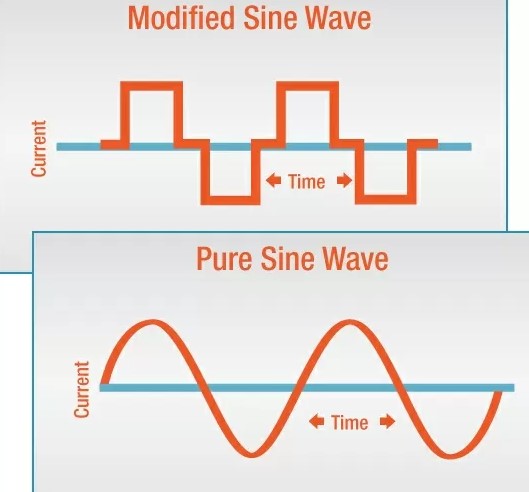When it comes to electricity, cleanliness matters. You may ask, “What does it mean for power to be clean?”
Clean power is free of distortions, fluctuations, and interruptions that can potentially damage sensitive electronics or cause operational issues.
This guide aims to educate you on how to ensure your generator power is clean and safe for use.
What is clean generator power?
Clean generator power produces consistent and accessible electricity from voltage or frequency fluctuations. This means the power output is stable, with minimal distortion or ‘noise.’ Noise can come in electrical spikes, surges, or dips (sags) beyond standard electrical norms. These abnormalities can cause damage to the equipment powered by the generator.
Dirty power is characterized by these inconsistencies and can lead to various problems, such as damaging sensitive electronic devices and appliances, causing operational issues, or even posing potential safety risks.
Generators, especially portable ones, are often used when utility power is unavailable. However, not all generators produce clean energy. Certain types, such as inverter generators, are designed to make cleaner, more stable power suitable for sensitive electronics like computers, televisions, and medical equipment.
The quality of power a generator produces can often be improved with regular maintenance, proper use, and sometimes through power conditioning devices like uninterruptible power supply (UPS) systems, power line filters, or high-quality surge protectors.

What is The Dirty Power?
Dirty power is a term used in the industry to refer to unstable or inconsistent electrical power supply. This inconsistency can come from voltage variations, frequency instability, or waveform distortions, often caused by various factors such as power surges, power sags, electrical noise, or harmonic distortion.
These abnormalities can be particularly problematic for sensitive electronics, as they can cause operational issues, premature wear and tear, and even complete failure.
Here are some forms of dirty power:
- Voltage Swells or Surges: This refers to a sudden increase in voltage that significantly exceeds the standard voltage level. This can damage electrical equipment and cause data loss in digital devices.
- Voltage Sags or Dips: Unlike surges, voltage sags or dips occur when the voltage drops below the standard level. These can cause machinery to malfunction or even shut down.
- Electrical Noise: This can be caused by electromagnetic interference or radio frequency interference, which can distort the clean power wave signal and lead to the malfunction of sensitive equipment.
- Harmonic Distortion: This distortion of the expected power wave is often caused by non-linear loads such as certain types of lighting or power electronic devices. This can cause a range of problems, from increased heating of equipment, misoperation of controls and devices, and the malfunction of electronic equipment.
- Voltage Fluctuation: Rapid variations in voltage can cause lights to flicker and may cause instability in some equipment.
- Frequency Variation: Most power systems require a constant frequency. Variations in frequency can affect the operation of electric motors and other equipment.
To protect your devices from dirty power, you may need to use power quality tools such as surge protectors, power conditioners, or uninterruptible power supply (UPS) systems.
Signs of Dirty Power in Generators
Dirty power from a generator can manifest in several ways. Here are some common signs that may indicate your generator is producing dirty power:
- Frequent Electrical Interruptions: Dirty power often causes circuits to trip or fuses to blow more frequently than usual. You may also notice your appliances or electronics unexpectedly turning off or rebooting.
- Electrical Noise: Buzzing sounds or visual static on screens, especially on radios, televisions, or audio equipment, can indicate electrical noise caused by dirty power.
- Inconsistent Lighting: Flickering lights or lights that dim and brighten without any adjustment can indicate power fluctuations.
- Overheating Devices: If your electrical devices, including your generator, are overheating or failing prematurely, this can be a sign of dirty power.
- Unexplained Device Malfunctions: Electronic devices like computers, printers, and other sensitive equipment might freeze, crash, or perform erratically.
- Increased Energy Consumption: If your energy consumption seems unusually high without a corresponding increase in usage, it could indicate power issues.
If you’re noticing any of these signs, it’s a good idea to investigate the power quality coming from your generator. Tools such as power quality analyzers can help measure and detect power abnormalities, giving you a clearer picture of the extent of the problem.
Depending on the issues, you may need to service or upgrade your generator, adjust its settings, or use power conditioning devices to clean up the power.
Why Do We Need Clean Power For Electronics?
Clean power is vital for electronics due to their sensitivity to power quality. The internal components and circuits in electronic devices are designed to operate within specific power parameters. When these parameters are disrupted or distorted, it can lead to multiple potential problems.
Here’s why we need clean power for electronics:
- Preventing Damage: Dirty power can cause physical harm to electronic devices. Surges or spikes in power can damage or destroy sensitive components, leading to system failure. Over time, even minor fluctuations can contribute to cumulative wear and tear, shortening the lifespan of the devices.
- Ensuring Correct Operation: Electronic devices depend on stable power to operate correctly. Fluctuations in power can cause operational problems, such as incorrect readings, erratic behavior, data corruption, and even system crashes in severe cases.
- Maintaining Data Integrity: Many electronic devices, particularly computers, and other data storage devices, require clean power to maintain data integrity. Power disturbances can cause data corruption or loss, which can be catastrophic in specific settings, such as data centers, hospitals, or financial institutions.
- Improving Energy Efficiency: Clean power can help improve electronic devices’ energy efficiency. Dirty power can cause devices to use more power than necessary, leading to increased energy costs.
- Enhancing User Safety: Power fluctuations can lead to overheating, sparking, or even fires in severe cases. Clean power helps to ensure the safe operation of electronic devices, protecting the user and the environment in which the device operates.
For these reasons, cleaning up the power supply to electronic devices is often necessary, mainly when the power source is a generator or another non-standard power supply. This can be achieved using surge protectors, uninterruptible power supply (UPS) systems, or power conditioners.
Is the inverter generator clean power?
Yes, inverter generators are designed to produce ‘clean’ power, characterized by a stable and consistent output of electrical current. They are particularly suited to power-sensitive electronics damaged by the power fluctuations and surges often associated with traditional generators.
Inverter generators accomplish this through a three-step process. First, the generator’s engine generates high-frequency AC power. This AC power is then converted to DC power. Finally, the DC power is ‘inverted’ back to AC power. This final AC power is clean and stable, with a smooth waveform similar to the power you get from your household outlets supplied by the utility company.
This clean power is critical for sensitive electronics like computers, medical devices, and home entertainment systems, which can be damaged by the ‘dirty’ power that conventional generators can sometimes produce. Dirty power is characterized by inconsistencies in the voltage or frequency of the electrical power output.
However, it is essential to note that even with an inverter generator, maintenance, and proper use are critical to ensure the generator continues producing clean power over time.
How to Clean Up Generator Power?
Cleaning up generator power is essential to ensure the longevity of your electronic devices and appliances. Here’s a step-by-step guide considering your mentioned points:
1. Use An Uninterrupted Power Supply (UPS):
An Uninterrupted Power Supply (UPS) is a device that provides emergency power when the input power source fails. The UPS system helps to maintain a stable voltage level, which can smooth out minor power fluctuations and provide short-term battery power during an outage.
Step 1: Choose a UPS that can handle the power demands of your appliances.
Step 2: Connect the UPS between your generator and your appliances. In case of any fluctuations, the UPS will kick in to provide clean, stable power.
2. Use An Automatic Voltage Regulator (AVR):
An Automatic Voltage Regulator (AVR) stabilizes the voltage levels output by the generator, helping to prevent harmful fluctuations that can damage your devices.
Step 1: Select an AVR compatible with your generator and can handle its output.
Step 2: Install the AVR as per the manufacturer’s instructions. This may require some technical skills; in some cases, you might need to call a professional.
3. Use A Power Line Conditioner:
A power line conditioner can adjust, clean, and stabilize the power from your generator. It can smooth out power spikes and dips, reduce electrical noise, and protect against damaging surges.
Step 1: Choose a power line conditioner that matches your appliances’ wattage and voltage requirements.
Step 2: Install the power line conditioner between your generator and appliances.
4. Call A Technician:
Suppose you’re experiencing significant power quality issues or are uncomfortable making these installations yourself. In that case, it may be time to call a professional.
Step 1: Locate a reputable technician or electrician in your area.
Step 2: Clearly explain the problems you’re experiencing and ask them to check your generator and power quality.
Step 3: Follow the advice and instructions provided by the technician. They might recommend repairs, adjustments, or the addition of power cleaning devices.
5. Use An Inverter Generator:
Inverter generators produce clean, stable power, ideal for powering sensitive electronic devices. Suppose you regularly deal with dirty power and your current generator is old or in poor condition. In that case, it might be time for an upgrade.
Step 1: Research an inverter generator that suits your power needs.
Step 2: Replace your old generator with the new inverter generator.
So, using clean power is essential to safeguard your sensitive home appliances. i hope, you have learn something necessary from this article.
Recent Posts
Yes, synthetic oil can generally be used in generators. It offers superior lubrication, improved resistance to temperature variations, and longevity compared to conventional oil, which can enhance...
In today's digital age, our dependency on computers and other electronic devices is undeniable. But what happens when a power outage occurs? This is where generators come in. However, is it safe to...
